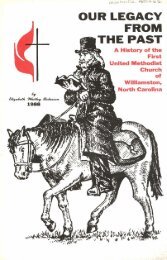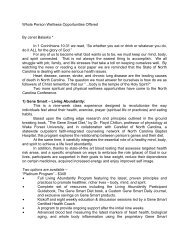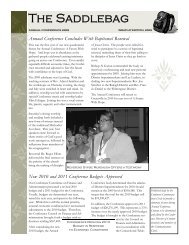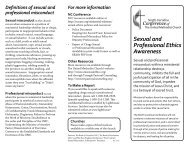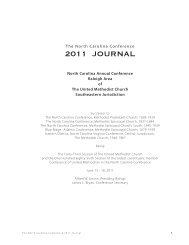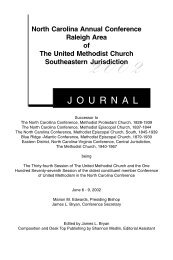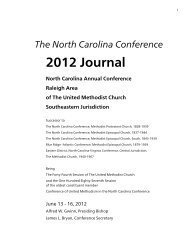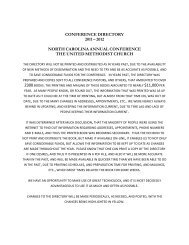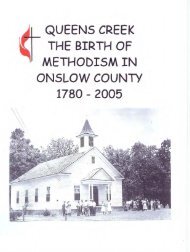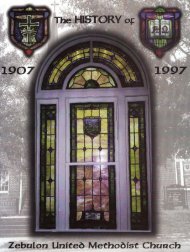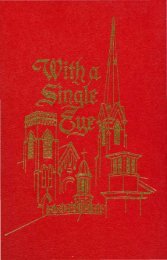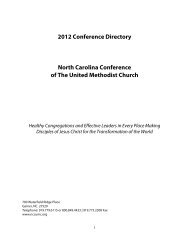Facing Tomorrow, Understanding Yesterday, A History of Orange ...
Facing Tomorrow, Understanding Yesterday, A History of Orange ...
Facing Tomorrow, Understanding Yesterday, A History of Orange ...
You also want an ePaper? Increase the reach of your titles
YUMPU automatically turns print PDFs into web optimized ePapers that Google loves.
Other longtime <strong>Orange</strong> Church members remembered meeting in<br />
thatsecond one-room structure. Mabel Maddry and Margaret Link, for<br />
instance,recalled that the interior <strong>of</strong> the old frame church was very small.<br />
Thechoir sat on the right side <strong>of</strong> the pulpit, and the Amen Corner was<br />
locatedon the left. The latter was populated by men <strong>of</strong> the church who<br />
weremost likely to vocally express their feelings during the service.<br />
Other men sat near them, with their wives sitting separately. This<br />
segregation<strong>of</strong> the sexes was customary during the early years <strong>of</strong> the<br />
church,and the 1841 roll lists male and female members on different<br />
pages- even when they were married to one another. The family concept<br />
forwhich<strong>Orange</strong> Church has become so well known obviously was quite<br />
differentin its early days.<br />
Pewsfor the congregation went up against the wall on both sides. Two<br />
largeposts, about four inches square, stood midway in the room, and a<br />
smalliron stove occupied the center <strong>of</strong> the room, although that was later<br />
movedto the right-hand comer. "We didn't have any stained glass<br />
windows,and the pulpit wasn't as high as it is now," said "Miss" Mabel<br />
Maddry,who was born a Freeland and grew up on Airport Road land<br />
oppositethe church that is now occupied by Duke Power. In addition,<br />
"Miss"Mabel recalled, 'There was a little old table that was used as a<br />
communiontable and the railing around our present pulpit is the same<br />
onethat was used in the old church. We had wooden steps, not cement."<br />
Margaret Link, who also grew up in the church, supplements "Miss"<br />
Mabel'srecollections. ''When I was a little bitty girl," she said, "they had<br />
abookcasein front <strong>of</strong> the pulpit, right in the center <strong>of</strong> the church, and the<br />
ministerused this to put the Bible on and any notes he had. The bookcase<br />
wasfilledwith books, and when they tore the old church down, they took<br />
thosebooks, I have been told, and stored them in the attic <strong>of</strong> one <strong>of</strong> the<br />
workers'homes, and they never could locate those books" later on.<br />
Landfor the church came from Alexander Gattis, Sr., a ruling elder<br />
intheNewHope Presbyterian Church, and Thomas King, each <strong>of</strong> whom<br />
deededtwo acres <strong>of</strong> land to the <strong>Orange</strong> Church trustees on October 31,<br />
1836. Initialtrustees were William Robson, Isaac]. Collier, Jones Watson,<br />
AbijahHatch, James Gattis, Daniel Hogan, Wesley Snipes, Jacob Potts,<br />
andWilliamGattis.<br />
Early church fathers ensured <strong>Orange</strong> Church's growth in special<br />
ways.In the nineteenth century, for instance, homes and institutions,<br />
suchas <strong>Orange</strong> Church, needed access to outside sources <strong>of</strong> water in<br />
orderto survive and prosper. The congregation was assured access to a<br />
springabout one-fourth <strong>of</strong> a mile northeast <strong>of</strong> the church. Dr. Charles<br />
Maddry,who once owned the farm east <strong>of</strong> the church, recalled that when<br />
thatland came into the Maddry family, the deed included provisions to<br />
ensurethat <strong>Orange</strong> Church had a steady and reliable supply <strong>of</strong> water. The<br />
springthat served this function also was the source <strong>of</strong> water for the<br />
WilliamC. Freeland home for many years until a well was dug there.<br />
Waterwas brought to the church from the spring and well in buckets.<br />
Duringbig meetings or for dinners held at the church, a large wooden<br />
barrelwith a spigot was filled with water from the Freeland place for use<br />
bythe congregation.<br />
Evenduring its earliest years, <strong>Orange</strong> Church played a special role in<br />
the development <strong>of</strong> Methodism in the community. Even though the<br />
church was three miles out <strong>of</strong> town, it was the preferred place for<br />
Methodistsin Chapel Hill to worship with others <strong>of</strong> their faith. In fact, the<br />
CarrboroMethodist Church history refers to the historic <strong>Orange</strong> Church<br />
as "the mother church <strong>of</strong> Methodism in this immediate vicinity." The<br />
situationbegan changing in 1840, when Charles F. Deems, a New Jersey<br />
Methodistpastor, arrived on the scene. At first sponsored by the American<br />
Bible Society, Deems <strong>of</strong>ten preached at <strong>Orange</strong> Church. By the<br />
summer<strong>of</strong> 1840, Deems and presiding elder Peter Doub conducted a<br />
series<strong>of</strong>camp meetings."<br />
FACING TOMORROW, UNDERSTANDING YESTERDAY 7<br />
<strong>Orange</strong> Church Group Picture<br />
First Frame Building<br />
Mabel Maddry<br />
Margaret Burch Link



